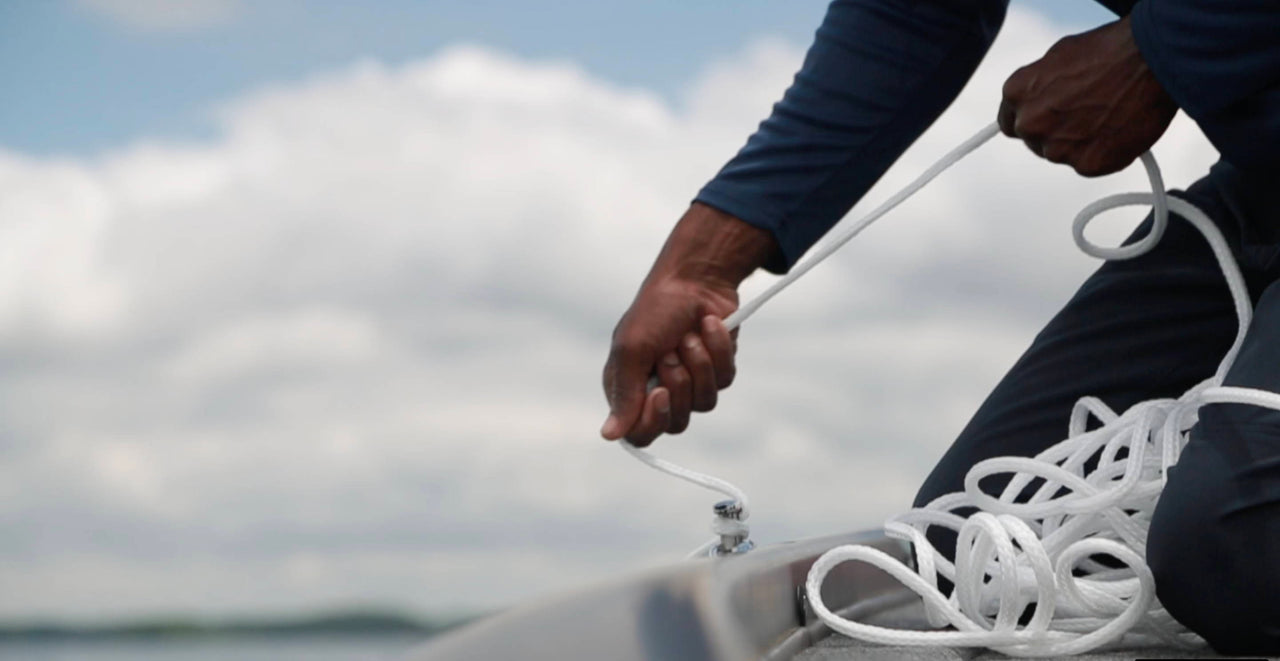Every boat should have an anchor, and some need more than one, but not all anchors are created the same. In fact, if you don’t have the right anchor, you’ll still be at the mercy of the wind and waves and not much better off than if you had no anchor at all. And the wrong anchor can even damage your boat or the area around your boat! No one needs that, so be sure to take a look at our Complete Recreational Boat Anchor Guide and the Top 10 Anchor Styles to Consider for your boat.

The Complete Recreational Boat Anchor Guide and Top 10 Anchor Styles to Consider
The Top 10 Recreational Boat Anchor Styles to Consider
Whether you’re pulling up at shore, resting in deeper waters, or staking out a fishing spot, effective anchoring means staying in place and having the right equipment to do so. This is true for paddle boats, PWCs, kayaks, canoes, jon boats, bass boats, “deep v” fishing boats, speed boats, cabin cruisers, and even the boats we didn’t list. At times, anchoring is simply a practical measure for pulling up somewhere for fun, but sometimes it’s a matter of stopping for safety. Either way, it’s your anchor that makes it easier and most effective.
As you look through the following guide, consider the size and style of your boat, the type of water you boat on, and the general type of bottom in that body of water (soft bottoms like sand, silt, and mud versus tight surfaces like packed shells, rocks, and structure). Also consider if you have enough variety in your travels where you should have a primary and a secondary anchor to meet varying anchor points. Bear in mind that this post is mostly about temporary anchors, so we don't cover deadweight anchors, auger-style anchors, and other more permanent anchor types, but look for another post in the future about those.
Here are the anchors covered in this post:
1. Shallow Water Anchors / Pole Anchors / Stick Anchors
5. Grappling Anchors / Grapnel Anchors
6. Navy Anchors / Kedge Anchors
8. Danforth Anchors / Fluke Anchors
9. Claw Anchors / Bruce Anchors
BONUS: These aren't truly anchors, but they're close and they can be very helpful.
1. Shallow Water Anchors / Pole Anchors / Stick Anchors
Pros:
- Lightweight
- Ideal for shallow water
- Scaled options for a variety of boats including stand up paddle boards, kayaks, micro skiffs, pontoons, and various inland and inshore fishing boats
- Manual and mechanical deployment options
- Causes minimal damage to vegetation and reefs
Cons:
- Price point
- Complexity of use
- Installation requirements
- Limited depth use — not for offshore use or water deeper than 15 feet
Notable Variations:
- Deployment design
- Pole length / depth use
- Mounting options (motor mount, stern mount, bow mount, pole spikes, etc)
- Wave absorption
- Controls and integrations
- Accessories (Lighting, drift paddles, covers, etc)
- Accent colors
2. Sand Anchors
- Weight is derived from sand or rocks and that weight does not have to travel with the boat
- Easy to use
- Compact and easy to stow
- Great for a personal watercraft, small paddle boat, or small kayak
- Perfect for anchoring PWC in shallow waters and keeping the impeller off the bottom
- Often includes a whole kit with a rope, snap hook, buoy, and storage bag
Cons:
- Limited use with personal watercraft, small paddle boats, and small kayaks
- Only reliable in shallow and calm water
- Some labor required to weigh anchor bag down
- Not recommended for inclimate weather
Notable Variations:
- Size and material
- Color
3. Mushroom Anchors
- Great for silt and mud and okay for sand bottoms
- Relatively compact
- Uses weight to settle into bottom and it’s design facilitates suction and friction to help it hold
- Usually incorporates drain holes for cleaner and easier retrieval
- Often coated to protect boat surfaces
- Usually budget-friendly
- Popular and often effective for paddle boats, canoes, jon boats, and other small watercraft
Cons:
- Holding power is not as good in areas where it can’t settle into the bottom
- Not recommended for rocky areas, weedy areas
Notable Variations:
- Protective coatings and colors
- Holes or slits
4. River Anchors
- Great for silt and mud
- Better than mushroom anchors for bottoms of sand, rock, or weeds
- Relatively compact
- Uses weight to settle into bottom plus a hybrid design of a mushroom shape plus flukes to grip and keep hold
- Often coated to protect boat surfaces
- Usually budget-friendly
- Effective for paddle boats, canoes, jon boats, and other small watercraft
Cons:
- Holding power is improved over mushroom anchors, but not the best
- Not recommended for boats that are larger than a jon boat
Notable Variations:
- Protective coatings and colors
- Fluke size and shape
5. Grappling Anchors / Grapnel Anchors
- Effective for weedy areas, hard and jagged bottoms, wrecks, and reefs
- Grapnel version is ideal and budget-friendly for kayaks and canoes
- Folding versions can be great for saving space and stowing away safely
- Most are designed so the tines (arms) have enough play to make them easily recovered from a snag
Cons:
- Much less effective on soft bottoms as it will often drag
- Can cause damage to vegetation and living reefs
- Often brings a mess of vegetation to the boat
- Subject to local rules about anchor effects on marine ecosystems
Notable Variations:
- Folding Grapnels
- DIY Grappling Anchors
6. Navy Anchors / Kedge Anchors
- Excellent in mud / sand bottoms and works for most other bottom conditions, too
- Flukes provide increased holding power
- Anchor shank design allows for a quick set
- Vinyl-coated versions are quieter, softer on boat surfaces, and resistant to corrosion
Cons:
- Relies greatly on its weight to work
- Doesn’t dig in as well as a Danforth Anchor / Fluke Anchor
Notable Variations:
- Vinyl-coatings
- Swivel Shank variations provide a quicker and easier set
- Incorporation of a chain, at a length variable to your needs, can help to absorb shock and improve holding power
- Hybrid Fluke / Navy Anchor from T-H Marine
7. Box Anchors
Pros:
- Best with muddy bottoms
- Relatively lightweight
- No chain required
- Popular with pontoon owners
- Hybrid concept uses flukes / claws
- Maximizes surface area contact with the bottom
- Square shape and flukes allow it to dig in
- Hinges and shank design allow it to fold up and release for retrieval
- Folds relatively flat for storage
Cons:
- Sharp and pointy edges can also be a threat to some boat surfaces
- For more weight, they require more size / surface area
- Cookie cutter design doesn’t dig in as well on bottoms of rock, packed shell, and other hard bottoms
Notable Variations:
- Size
- Quality of materials / manufacturing
8. Danforth Anchors / Fluke Anchors
- Regarded as a good all-around anchor
- Style can be a good fit for a wide variety of boats
- Often a solid choice as a primary anchor or a back-up anchor
- Relatively lightweight
- Relies greatly on its design to work
- Excels at digging in
Cons:
- Pointed flukes can hold too well on stumps, wrecks, and reefs
- Sharp and pointy edges can also be a threat to some boat surfaces
- For more weight, they require more size / surface area
- On bottoms of rock, packed shell, and other hard bottoms, they tend to skip along without digging in
- Cheaper versions may be more prone to breaking and poor performance
Notable Variations:
- Varying fluke angles
- Material composition
- Chain length (Incorporation of a chain, depending on length, can impact absorb shock and improve holding power)
- Hybrid Fluke / Navy Anchor from T-H Marine
9. Claw Anchors / Bruce Anchors
- Good holding power for its size
- Sets like a plow, but curved flukes help it to right itself
- Works great on rocks, coral, and jagged bottoms
- Tends to stay secure when push and pull change
- Claw design allows anchor to turn in a circle without breaking out
- Exceptional in windy conditions, where the boat is being pushed in various directions
- Usually the top choice for big, open bodies of water
- Smaller kayak versions available
Cons:
- Weakest in sand, silt, and mud
- Can struggle to keep hold on clay bottoms and grassy bottoms
- Entangled vegetation makes retrieval more difficult
- Shape and size requires more storage space
Notable Variations:
- Hybrid versions that incorporate a spade-like claw
- Inclusion of a roll bar
- Incorporation of a chain (length variable to needs) to absorb shock and improve holding power
10. Plow Anchors / Plough Anchors / Wing Anchors / Delta Anchors / CQR Anchors (Coastal Quick Release)
- Shank and plates allow the anchor to plow into the bottom
- Good holding power in nearly all other bottom types (though this can vary with each design, this generally includes mud, sand, rock, vegetation, and coral)
- One of the easier anchors to set and recover
- Design makes it less likely to hold onto a wreck or harm a reef
- Great for deep water and offshore use
- Stores easily on a bow roller (and often interchangeably anchors of the same size)
Cons:
- Can dislodge with upward movement of waves
- May plow through mud, sand, and silt under certain conditions, preventing it from holding position
- Bigger anchors of this type perform better and this type struggles to perform when under 26 pounds
- Some boaters say it has poor performance when compared to other anchors suited for specific use cases
- If not kept on a bow roller, shape and size requires more storage space
Notable Variations:
- Materials / Finishes
- Some have a fixed shank while others have a hinge for more responsiveness to wind and tide changes and keeping it set.
- Incorporation of a chain, at a length variable to your needs, can help to absorb shock and improve holding power
Not Exactly Anchors, but a Close Fit for Our Boat Anchor Guide
In the interest of being comprehensive and mentioning a few options that aren’t too far removed from anchoring, here are a few other options to consider if you aren’t dropping anchor, tying up, or maintaining position with a top of the line trolling motor.
Explore Your Options with Boating Essentials Anchors and Anchoring Accessories
It may be tough to settle on just one anchor, but the good news is that with the Boating Essentials collection, you have plenty of choices for keeping your boat right where you want it. Whether you need a primary anchor, a secondary anchor, or both, make sure to keep size, weight, and design in mind for the conditions you’ll encounter.






